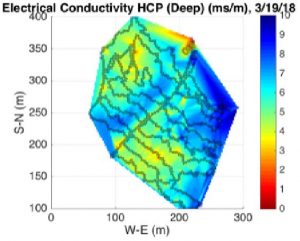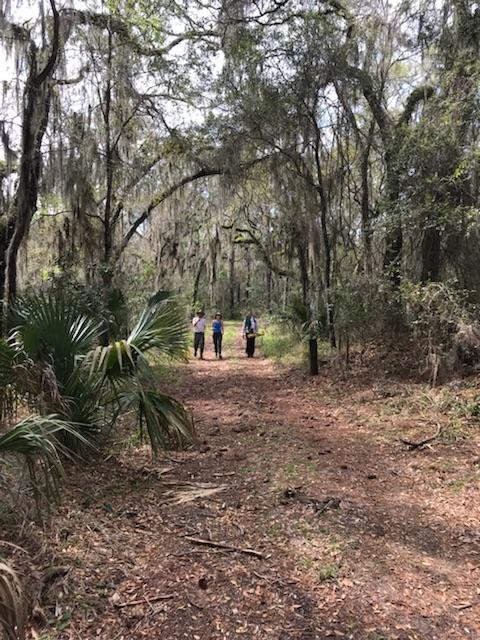This Spring Break, Lizzie and Dessa spent three days on Jekyll Island conducting soil mapping surveys with Lizzie’s long-time collaborator, Trenton Franz from the University of Nebraska – Lincoln. With the energetic help of Rose Parham (Ecology major) and Weston Freund (Warnell major); recently graduated Engineering major Andrew Berecz; and Americorps volunteer Cailin Lutz, they used electromagnetic induction (EMI) to map the electrical conductivity of the upper ~3m of soil in the live oak maritime forest. The survey was conducted in a 4ha area where Field Research Coordinator Extraordinaire Ruth Cumberland had previously mapped the location, size, and species of every single tree and sapling. As an added bonus, we got heavy rain between our two repeat surveys, which can help us interpret how water and soil texture are contributing to the conductivity signal. From a VERY preliminary look at the data, it appears that conductivity varies along the elevation gradient, but also shows some lateral variation not explained by elevation. Also, it would appear that areas where large live oaks dominate, and laurel oak seedlings are absent, are characterized by higher soil conductivity — likely an indicator of enriched soil organic matter and thus soil water holding capacity in these very sandy soils.
 And yet another bonus: the EMI surveys also identified a large band of notably higher conductivity, at approx 2m depth, running across part of the site, which could be a geological formation (like a clay layer nearer the surface) or an artifact of some past land use. Guided by the EMI data, we can mount a targeted soil augering expedition to find out more. As Trenton said many times, after EMI surveys, all roads lead to digging!
And yet another bonus: the EMI surveys also identified a large band of notably higher conductivity, at approx 2m depth, running across part of the site, which could be a geological formation (like a clay layer nearer the surface) or an artifact of some past land use. Guided by the EMI data, we can mount a targeted soil augering expedition to find out more. As Trenton said many times, after EMI surveys, all roads lead to digging!
